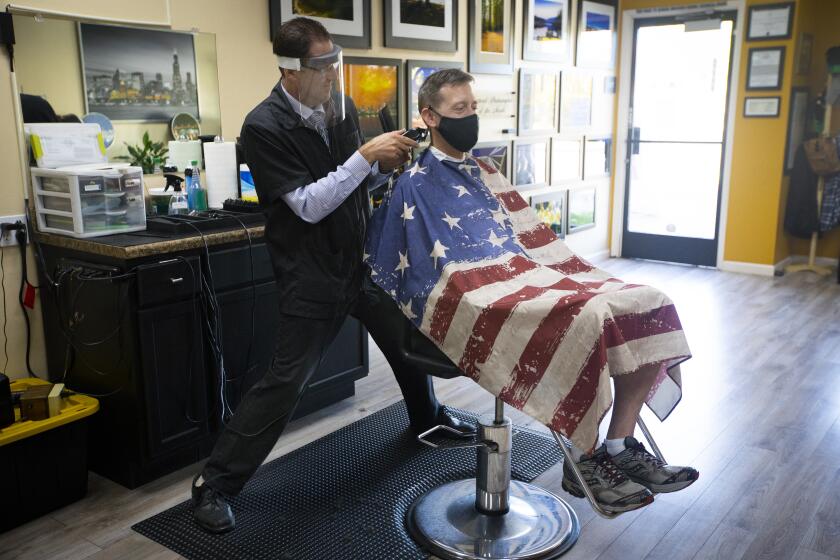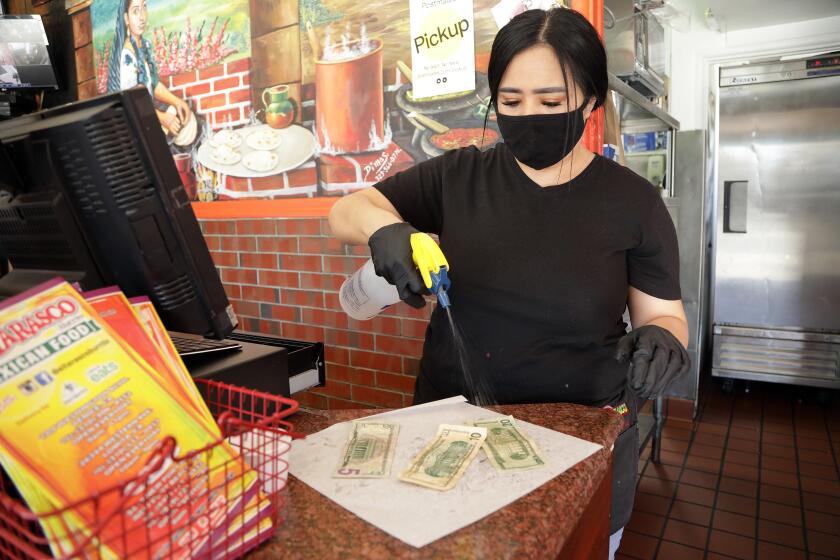California leased 15,000 hotel rooms to help homeless people. Half now sit empty

- Share via
Only about half of the 15,000 hotel and motel rooms that California has leased for mostly homeless people to slow the spread of the coronavirus are now occupied, a review of state records by The Times shows.
More than a month into Gov. Gavin Newsom’s program to get homeless people off the streets, the occupied rooms account for — at most — less than 5% of the 151,000 people who sleep on street corners, under bridges and in emergency shelters across California.
As of Monday, 7,919 hotel rooms had guests and another 7,700 were vacant, according to figures released by Newsom’s office.
Visual look at the third phase to reopen California amid the coronavirus outbreak.
The actual number of rooms leased for homeless people in the statewide program known as Project Roomkey could be even lower since Newsom’s goal also included rooms reserved for people, homeless or not, who needed to quarantine or isolate themselves because of the coronavirus.
What Newsom launched in early April as a coordinated effort to address homelessness during the pandemic has led to mixed results. But, in general, it has progressed so slowly that it has fallen short of many expectations and is unlikely to get most of those who need help indoors.
In some counties, the largest impediments have been delays in preparing leased rooms for occupancy, not, as the governor has complained, NIMBY interests at the local level. In other counties, it has been a shortage of staff to care for homeless residents, providing services, such as food services, security, nursing and case management.
“This has not been a challenge of leasing hotels,” said Sacramento Mayor Darrell Steinberg, who is co-chair of the state’s homelessness task force. “The challenge is much more in insufficient numbers of service providers to deal with a much larger capacity of people and a big question about rehousing.”
Under the program, county officials are responsible for determining how many rooms to set aside for homeless people. But the actual implementation of Project Roomkey is forcing officials from many counties to question how many homeless people “the program can bring in,” Steinberg said. That’s because there aren’t enough service providers to help run the hotels and eventually help transition the residents into permanent housing.
Sacramento County is doing better than the state as a whole, with two-thirds of the 420 rooms it leased now filled. But because of the backlog of people waiting for a room, it has held off on signing leases for another 570 rooms, Steinberg said.
It’s a predicament that has not yet arisen in Los Angeles County, where the pace has been set by how fast negotiators have been able to sign leases with hotels and motels. The Los Angeles Homeless Services Authority has filled most rooms within two to three days of their availability. But that could change as the agency finds the ranks of local service providers thinning.
At 76, Judge David Carter knows he shouldn’t be on skid row exposing himself to the coronavirus. But he wants more for L.A.’s homeless people.
“We’re frankly getting close to understanding what our system capacity is,” said LAHSA’s interim Executive Director Heidi Marston. “Our big [service] providers are getting stretched. That’s a very real concern. Unless we can bring in more human capital to do this work, we’re going to have a hard time continuing to expand capacity.”
Project Roomkey is largely funded by the Federal Emergency Management Agency, which has vowed to reimburse the state and individual counties for 75% of the cost of leasing hotel rooms and providing services. Only homeless people who meet certain criteria, including being older than 65 and having health conditions that make them susceptible for dying of COVID-19, qualify.
However, only rooms that are occupied are covered by FEMA under the program. And while it’s unclear whether some counties are paying hotel owners for rooms that they have leased but haven’t filled, that is not happening in L.A. County.
The program’s goal of leasing 15,000 rooms would be enough to house about 10% of California’s estimated homeless population — a figure that falls far short of the total number of homeless people in the state who are 65 or older or have chronic medical conditions such as heart disease or diabetes.
In Los Angeles County alone, officials have identified 15,000 people — a quarter of the county’s homeless population — who meet the age or health criteria and set that as its goal. As of Monday, the county had secured 3,245 rooms and moved guests into 2,102.
Statewide data provided by Newsom’s office on Monday showed that two large Southern California counties have more trouble filling rooms. San Diego has filled only about 20% of the 2,029 rooms it has under lease, and Orange County just under 30% of its 666 rooms.
A senior official with Newsom’s administration told The Times that the state was very proud of the pace and scale at which counties have gotten homeless people into hotels and motels. It’s an effort that took weeks and otherwise would’ve taken months or years. This official said the state still wants to see counties moving faster to fill beds and bring people indoors.
The state data doesn’t specify how many of the leased rooms are for those in need of quarantine or isolation for COVID-19, as opposed to those who are homeless.
Craig Sturak, a spokesman for the San Diego County Health Department, gave slightly different numbers than the state, saying Friday that the county had about 1,700 rooms leased and 370 rooms occupied. Many of the beds were secured before Project Roomkey began, he said, “in anticipation of a large number of COVID-19 cases that would not require hospitalization but also would not be able to isolate at home.”
About 200 of the 370 rooms are for homeless people older than 65 with underlying health conditions, he said.
Sturak didn’t explain why so many beds that could be used to house homeless people are empty, even as thousands remain on the streets, but said “there are other resources and programs to serve homeless individuals who do not need the level of care provided at these rooms.”
The San Diego Convention Center, famous for hosting Comic-Con and other events, is housing nearly 1,200 homeless people during the pandemic. Most were brought there from cramped shelters, where the virus is more likely to spread.
Joel Jon Roberts, chief executive of the statewide homeless services and housing development agency PATH, said that San Diego’s leaders are well aware of what might happen if there’s a sudden jump in coronavirus cases among the local homeless population. According to the county’s federally mandated point-in-time count, 7,619 homeless people were living outdoors or in shelters as of January, a 6% drop from the previous year.
“My sense is that they are trying to keep rooms open in case of an outbreak,” he said. “Nobody knows what the number could be. Look at New York City and how bad it’s been there.”
In addition to running shelters in San Diego, PATH is providing services at four leased hotels in Los Angeles County as well. While it has been able to fill rooms quickly, in some cases, it has taken more than two weeks to get rooms ready after the leases are signed.
Los Angeles Times’ visual coverage of the coronavirus crisis
More than 600 unoccupied rooms are in hotels that are not yet ready to open — in some cases because former guests had yet to leave or in others because repairs were needed.
L.A. city and county negotiators have struggled to strike deals with large hotels near downtown, where the highest concentration of homeless people live on the streets in skid row. Including several smaller hotels in the vicinity of downtown, there are enough rooms for less than 4% of the area’s homeless population, according to a Times analysis.
But the owners of some small hotels and motels have complained of being shut out of the process. LAHSA, which is responsible for operating the hotels, has asked negotiators to target properties of 100 rooms or more to ease the logistics of contracting for food service, security, healthcare and case management.
Echoing Steinberg, Roberts said his agency has had to scramble to find people with the proper training to help run the hotel shelters. Still, he’s very pleased with how quickly they’ve gotten rooms up and running.
“We can’t just, next week, hire 20 clinicians to do this kind of work,” he said. “So we’re moving people from outreach and other contracts.”
At least two Southern California counties have outpaced Los Angeles in filling hotel and motel rooms, though they both have much smaller homeless populations.
Riverside, which rented individual rooms rather than whole hotels, has secured 266 rooms and has filled them all — a number accounting for about 10% of its homeless population. Ventura County started working on rooms in mid-March and has among the state’s highest success rates. Its 388 rooms are more than 80% occupied.
Tara Carruth, manager of Ventura County’s homeless oversight agency, said hotel owners were eager to lease rooms and the county provided staffing. In total, the county identified about 350 people who met the age or health criteria for Project Roomkey — or about 27% of its homeless population — and has leased enough rooms to accommodate that number and more.
Even as rooms eventually fill up, the impact of the statewide program will be hard to gauge, partly because of the duplicate goal of both L.A. County and the state to get 15,000 homeless people off the streets, and a lack of accurate population data for comparison.
Acknowledging that the pace of leasing rooms and the limits on staffing for services will probably put the county’s goal out of reach, Marston said she’s not backing down. There has been a lot of enthusiasm for Project Roomkey despite its shortcomings.
“I do think there are ways of serving 15,000 people,” Marston said. “We have built an amazing capacity. Let’s keep building the capacity we have and turn the rooms over so we can serve more people.”
More to Read
Sign up for Essential California
The most important California stories and recommendations in your inbox every morning.
You may occasionally receive promotional content from the Los Angeles Times.











